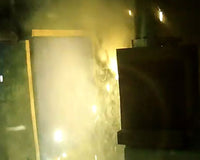Electrical Safety Don'ts
- Don't re-close any circuit which has been opened by a fault unless the fault has been located and isolated or rectified.
- Don't open the supply to a motor/alternator set until the alternator load has been disconnected.
- Don't energise the primary winding of a current transformer with the secondary winding open-circuit, or open-circuit the secondary winding while current if flowing, or is capable of flowing, in the primary winding.
- Don't approach the circuit after isolation until it is proven to be dead and discharged by a competent person
- Don't Interfere with any safety devices, trips and interlocks etc. on test equipment.
- Don't cross exclusion barriers with H.V is present or whist the circuit is not isolated.
- Don't alter the permanent connections of any test equipment without the knowledge and agreement of the relevant supervisor.
- Don't test equipment in a modified state must be labelled. Connections must be properly replaced after use, unless otherwise agreed.
- Don't use faulty equipment or leave equipment in a condition that could endanger others
- Don't neglect injuries, however slight, nor neglect to have them attended to by a trained first aider
Electrical Safety Do's
-
Do be certain that equipment is completely dead and cannot be energised inadvertently before allowing any work to be carried out. Use a control sheet to measure these steps and make a judgement on the need for written instructions e.g. permits to work.
-
Do work to a method statement or work/test instruction, use the associated control sheet if appropriate and follow the best housekeeping practices.
-
Do use properly insulated probes, prods and tools and adequately rated instrument leads and probes.
-
Do follow correct switching sequence e.g. close an isolator first before closing the associated circuit-breaker
-
Do arrange an adequate exclusion area around the equipment under test
-
Do be safety conscious and ask yourself: “what if I/he/she/someone/that object should happen to touch/fall/run into… and take appropriate preventative measures where necessary
-
Do challenge any person who is believed to be contravening the rules for access into your test area. Be polite but insist that they follow the correct procedures.
-
Do arrange the layout of all equipment in an orderly manner to provide, but not limited to, adequate working space, a normal working position, ease of access to equipment, ease for reading instructions, adequate lighting, ease of access in an emergency




